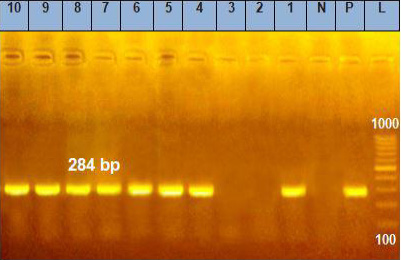Prevalence, Conventional and Molecular Characterization of Salmonella Isolated from Chicken Farms and Slaughterhouses
Prevalence, Conventional and Molecular Characterization of Salmonella Isolated from Chicken Farms and Slaughterhouses
Mohammed H. Galhoum1, Hamza M. Eed2, Essam S. Soliman1*
Biochemical positive tests for the isolated Salmonella. A. Triple sugar iron agar (N, negative tube; P, positive with the blackening, and P, positive with the fermentation action with gas production only). B, Lysine iron agar (N, negative tube; P, positive tube with the partial fermentation action, positive tube with the complete fermentation action, and P, positive tube with the blackening. C, Simmons citrate (N, negative tube and P, positive tube with the development of the blue color), D, Methyl red (N, negative tube and P, positive tube with the development of the red color).
Gel electrophoresis UV images showing representative samples with positive bands (1 and 4: 10) and negative samples (2 and 3) compared to the ladder, positive, and negative controls.









